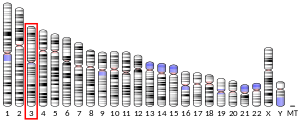Nucleoporin 210kDa
Nuclear pore glycoprotein-210 (gp210) is an essential trafficking regulator in the eukaryotic nuclear pore complex. Gp-210 anchors the pore complex to the nuclear membrane.[5] and protein tagging reveals its primarily located on the luminal side of double layer membrane at the pore. A single polypeptide motif of gp210 is responsible for sorting to nuclear membrane,[6] and indicate the carboxyl tail of the protein is oriented toward the cytoplasmic side of the membrane.
Disassembly and Assembly
During eukaryotic mitosis the nuclear envelope disintegrates into vesicles dispersing nuclear lamina proteins and nuclear pore complexes. Nup210 is specifically phosphorylated on the C-terminal (cytoplasmic) domain in mitosis at Ser1880[7] and is dispersed throughout the endoplasmic reticulum during mitosis as homodimers.[8] Nuclear lamins begin to reassemble around chromosomes at the end of mitosis.[9] Nup210 lags the reassembly process relative to other Nups.[10] and while much of the assembly process can occur without it, the final assembly and dilation of the complexes require Nup210.[11] The replacement of serine at position 1880 with a phosphorylated 'looking' glutamate results in Nup210 complexes that fail to reassemble indicating that dephosphorylation of Nup210 within the final phases of proper assembly is required.[12]
Pathology
Recognized by anti-nuclear antibodies found in primary biliary cirrhosis (PBC) anti-Nup210 antibodies correlate with progression toward end stage liver disease. Nup210 is possibly a destructive autoimmune target of the disease. One idea for the loss of tolerance is the increased or abnormal expression of Nup210 in patients with PBC.[13]
Anti-mitochondrial, anti-centromere and anti-nup62 are also found in PBC.
References
- GRCh38: Ensembl release 89: ENSG00000132182 - Ensembl, May 2017
- GRCm38: Ensembl release 89: ENSMUSG00000030091 - Ensembl, May 2017
- "Human PubMed Reference:". National Center for Biotechnology Information, U.S. National Library of Medicine.
- "Mouse PubMed Reference:". National Center for Biotechnology Information, U.S. National Library of Medicine.
- Greber UF, Senior A, Gerace L (1990). "A major glycoprotein of the nuclear pore complex is a membrane-spanning polypeptide with a large lumenal domain and a small cytoplasmic tail". EMBO J. 9 (5): 1495–502. doi:10.1002/j.1460-2075.1990.tb08267.x. PMC 551841. PMID 2184032.
- Wozniak RW, Blobel G (1992). "The single transmembrane segment of gp210 is sufficient for sorting to the pore membrane domain of the nuclear envelope". J. Cell Biol. 119 (6): 1441–9. doi:10.1083/jcb.119.6.1441. PMC 2289754. PMID 1281815.
- Favreau C, Worman HJ, Wozniak RW, Frappier T, Courvalin JC (1996). "Cell cycle-dependent phosphorylation of nucleoporins and nuclear pore membrane protein Gp210". Biochemistry. 35 (24): 8035–44. doi:10.1021/bi9600660. PMID 8672508.
- Favreau C, Bastos R, Cartaud J, Courvalin JC, Mustonen P (2001). "Biochemical characterization of nuclear pore complex protein gp210 oligomers". Eur. J. Biochem. 268 (14): 3883–9. doi:10.1046/j.1432-1327.2001.02290.x. PMID 11453980.
- Yang L, Guan T, Gerace L (1997). "Integral membrane proteins of the nuclear envelope are dispersed throughout the endoplasmic reticulum during mitosis". J. Cell Biol. 137 (6): 1199–210. doi:10.1083/jcb.137.6.1199. PMC 2132536. PMID 9182656.
- Bodoor K, Shaikh S, Salina D, et al. (1999). "Sequential recruitment of NPC proteins to the nuclear periphery at the end of mitosis". J. Cell Sci. 112 (13): 2253–64. PMID 10362555.
- Cohen M, Feinstein N, Wilson KL, Gruenbaum Y (2003). "Nuclear pore protein gp210 is essential for viability in HeLa cells and Caenorhabditis elegans". Mol. Biol. Cell. 14 (10): 4230–7. doi:10.1091/mbc.E03-04-0260. PMC 207014. PMID 14517331.
- Onischenko EA, Crafoord E, Hallberg E (2007). "Phosphomimetic mutation of the mitotically phosphorylated serine 1880 compromises the interaction of the transmembrane nucleoporin gp210 with the nuclear pore complex". Exp. Cell Res. 313 (12): 2744–51. doi:10.1016/j.yexcr.2007.05.011. hdl:10616/41278. PMID 17559836.
- Nakamura M, Takii Y, Ito M, et al. (2006). "Increased expression of nuclear envelope gp210 antigen in small bile ducts in primary biliary cirrhosis". J. Autoimmun. 26 (2): 138–45. doi:10.1016/j.jaut.2005.10.007. PMID 16337775.



